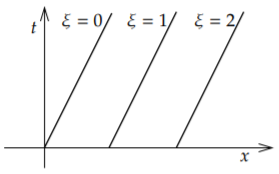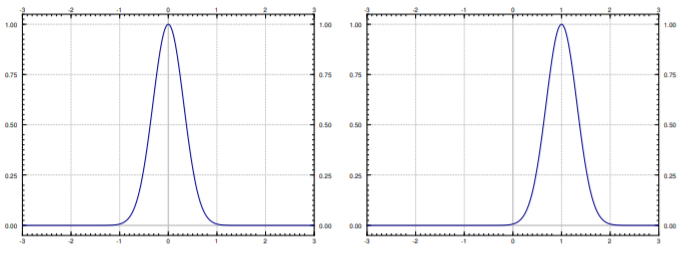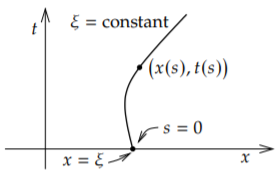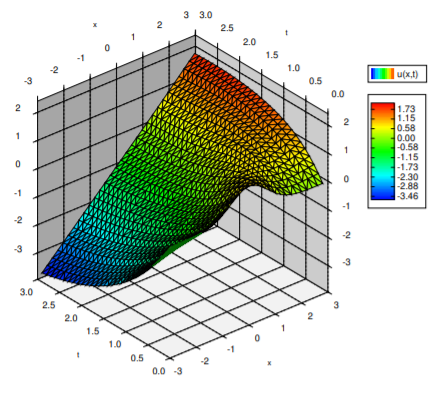12.10: First Order Linear PDE
- Last updated
- May 12, 2023
- Save as PDF
- Page ID
- 128063
( \newcommand{\kernel}{\mathrm{null}\,}\)
We only considered ODE so far, so let us solve a linear first order PDE. Consider the equation a(x,t)ux+b(x,t)ut+c(x,t)u=g(x,t),u(x,0)=f(x),−∞<x<∞,t>0, where u(x,t) is a function of x and t. The initial condition u(x,0)=f(x) is now a function of x rather than just a number. In these problems, it is useful to think of x as position and t as time. The equation describes the evolution of a function of x as time goes on. Below, the coefficients a, b, c, and the function g are mostly going to be constant or zero. The method we describe works with nonconstant coefficients, although the computations may get difficult quickly.
This method we use is the . The idea is that we find lines along which the equation is an ODE that we solve. We will see this technique again for second order PDE when we encounter the wave equation in Section 4.8.
Example 12.10.1
Consider the equation ut+αux=0,u(x,0)=f(x). This particular equation, ut+αux=0, is called the transport equation.
The data will propagate along curves called characteristics. The idea is to change to the so-called characteristic coordinates. If we change to these coordinates, the equation simplifies. The change of variables for this equation is
ξ=x−αt,s=t.
Let’s see what the equation becomes. Remember the chain rule in several variables.
ut=uξξt+usst=−αuξ+us,ux=uξξx+ussx=uξ.
The equation in the coordinates ξ and s becomes
(−αuξ+us)⏟ut+α(uξ)⏟ux=0,
or in other words us=0.
That is trivial to solve. Treating ξ as simply a parameter, we have obtained the ODE duds=0.
The solution is a function that does not depend on s (but it does depend on ξ). That is, there is some function A such that u=A(ξ)=A(x−αt). The initial condition says that: f(x)=u(x,0)=A(x−α0)=A(x), so A=f. In other words, u(x,t)=f(x−αt). Everything is simply moving right at speed α as t increases. The curve given by the equation ξ=constant
is called the characteristic. See Figure 12.10.1. In this case, the solution does not change along the characteristic.

In the (x,t) coordinates, the characteristic curves satisfy t=1α(x−ξ), and are in fact lines. The slope of characteristic lines is 1α, and for each different ξ we get a different characteristic line.
We see why ut+αux=0 is called the transport equation: everything travels at some constant speed. Sometimes this is called . An example application is material being moved by a river where the material does not diffuse and is simply carried along. In this setup, x is the position along the river, t is the time, and u(x,t) the concentration the material at position x and time t. See Figure 12.10.2 for an example.

We use similar idea in the more general case: aux+but+cu=g,u(x,0)=f(x). We change coordinates to the characteristic coordinates. Let us call these coordinates (ξ,s). These are coordinates where aux+but becomes differentiation in the s variable.
Along the characteristic curves (where ξ is constant), we get a new ODE in the s variable. In the transport equation, we got the simple duds=0. In general, we get the linear equation duds+cu=g.
We think of everything as a function of ξ and s, although we are thinking of ξ as a parameter rather than an independent variable. So the equation is an ODE. It is a linear ODE that we can solve using the integrating factor.
To find the characteristics, think of a curve given parametrically (x(s),t(s)). We try to have the curve satisfy dxds=a,dtds=b. Why? Because when we think of x and t as functions of s we find, using the chain rule, duds+cu=(uxdxds+utdtds)⏟duds+cu=aux+but+cu=g.
So we get the ODE (???), which then describes the value of the solution u of the PDE along this characteristic curve. It is also convenient to make sure that s=0 corresponds to t=0, that is t(0)=0. It will be convenient also for x(0)=ξ. See Figure 12.10.3.

Example 12.10.2
Consider ux+ut+u=x,u(x,0)=e−x2. We find the characteristics, that is, the curves given by dxds=1,dtds=1. So x=s+c1,t=s+c2, for some c1 and c2. At s=0 we want t=0, and x should be ξ. So we let c1=ξ and c2=0: x=s+ξ,t=s.
The ODE is duds+u=x, and x=s+ξ. So, the ODE to solve along the characteristic is duds+u=s+ξ. The general solution of this equation, treating ξ as a parameter, is u=Ce−s+s+ξ−1, for some constant C. At s=0, our initial condition is that u is e−ξ2, since at s=0 we have x=ξ. Given this initial condition, we find C=e−ξ2−ξ+1. So,
u=(e−ξ2−ξ+1)e−s+s+ξ−1=e−ξ2−s+(1−ξ)e−s+s+ξ−1.
Substitute ξ=x−t and s=t to find u in terms of x and t: u=e−ξ2−s+(1−ξ)e−s+s+ξ−1=e−(x−t)2−t+(1−x+t)e−t+x−1. See Figure 12.10.4 for a plot of u(x,t) as a function of two variables.

When the coefficients are not constants, the characteristic curves are not going to be straight lines anymore.
Example 12.10.3
Consider the following variable coefficient equation: xux+ut+2u=0,u(x,0)=cos(x).
We find the characteristics, that is, the curves given by dxds=x,dtds=1. So x=c1es,t=s+c2.
At s=0, we wish to get the line t=0, and x should be ξ. So x=ξes,t=s.
OK, the ODE we need to solve is duds+2u=0.
This is for a fixed ξ. At s=0, we should get that u is cos(ξ), so that is our initial condition. Consequently, u=e−2scos(ξ)=e−2tcos(xe−t).
We make a few closing remarks. One thing to keep in mind is that we would get into trouble if the coefficient in front of ut, that is the b, is ever zero. Let us consider a quick example of what can go wrong: ux+u=0,u(x,0)=sin(x). This problem has no solution. If we had a solution, it would imply that ux(x,0)=cos(x), but ux(x,0)+u(x,0)=cos(x)+sin(x)≠0. The problem is that the characteristic curve is now the line t=0, and the solution is already provided on that line!
As long as b is nonzero, it is convenient to ensure that b is positive by multiplying by −1 if necessary, so that positive s means positive t.
Another remark is that if a or b in the equation are variable, the computations can quickly get out of hand, as the expressions for the characteristic coordinates become messy and then solving the ODE becomes even messier. In the examples above, b was always 1, meaning we got s=t in the characteristic coordinates. If b is not constant, your expression for s will be more complicated.
Finding the characteristic coordinates is really a system of ODE in general if a depends on t or if b depends on x. In that case, we would need techniques of systems of ODE to solve, see Chapter 3 or Chapter 8. In general, if a and b are not linear functions or constants, finding closed form expressions for the characteristic coordinates may be impossible.
Finally, the method of characteristics applies to nonlinear first order PDE as well. In the nonlinear case, the characteristics depend not only on the differential equation, but also on the initial data. This leads to not only more difficult computations, but also the formation of singularities where the solution breaks down at a certain point in time. An example application where first order nonlinear PDE come up is traffic flow theory, and you have probably experienced the formation of singularities: traffic jams. But we digress.

